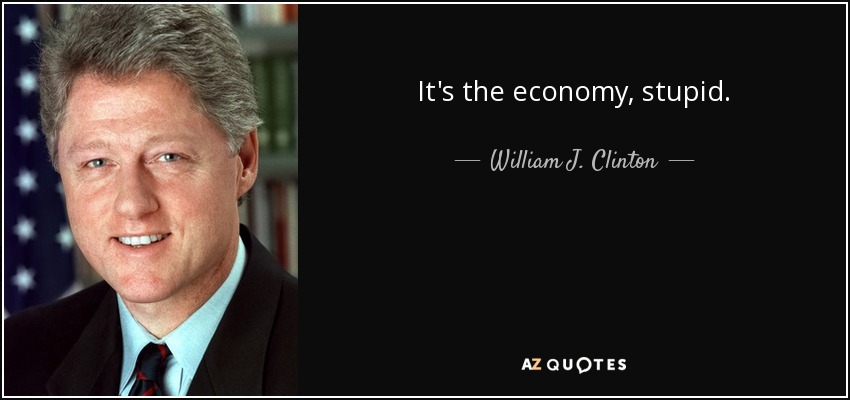Game design hates virtuous circles. If the player does well, throw a bigger monster with a +5 sword of game-balancing at them. If the player has too much gold, make the cost of health potions rise. Thats the way our forefathers designed games. Sadly, the game I am making (Democracy 4) is based on real life, and not J R R Tolkien, so I cant cheat like that. Plus, Democracy 4 is more of a sandbox than a traditional ‘beat level 6!’ style game. How can I solve this?
ITS ALL ABOUT GDP, STUPID.
Bill Clinton had this phrase, ‘its all about the economy, stupid’, to remind him what mattered. Bill was a big player of Democracy 4. If GDP is high, tax income is high, so you can cut taxes (happy people) or ramp up public services and welfare (happy people). Get the economy (GDP) higher, and re-election is trivial. This is all modeled with some accuracy in the game.

However… its not balanced right yet in the game (hurrah for Early Access), because far too many hardcore players of the game shout at me that their GDP is 100% and will not go any higher. This is because there are not enough effects that reduce GDP, to balance the game, and the boosts to GDP are likely too linear…
There are a LOT (79 distinct things) of inputs to GDP in the game, but to list some of the biggest ones:
- Worker Productivity
- Corruption
- Oil Price
- Global Economy
- Foreign Investment
- Corporation/Carbon Taxes
- Business Confidence
- Income & other taxes…
There are also some good, and bad situations that can have huge effects, such as a debt crisis, hyperinflation, corporate exodus and strikes, or technological backwater… GDP also has a LOT of outputs (80) the largest of which are:
- Currency Strength
- Foreign Aid Inflows
- Air Travel
- The Environment
- Costs and income from many different policies/taxes etc
- Unemployment
- CO2 Emissions
- Obesity
There are basically three ways to fix the problem I have where GDP gets too high. I can change some of the inputs to GDP so they follow more of a curve, declining towards the top. I can boost some of the negative impacts of high GDP, maybe accelerating at the top, and I can imagine new links/situations/impacts that are negative, yet associated with high GDP.
For example, if we look at one of the strongest impacts that boosts GDP (Worker Productivity), its equation in the game is as follows: GDP,0+(x*0.44). This is, to put it bluntly, pretty simplistic, and maps onto a curve like this:
I know how simple this looks, but don’t forget there are THOUSANDS of equations in the game. They are not all works of art :D. The obvious solution to avoid the kind of game-design problem I have is to make that curve less linear. Maybe adjusting it to GDP,0.4*&x^0.76) which looks like this in comparison:
This feels a bit better, because it implies that the earlier productivity gains have a stronger effect (which sounds true… worker uses horse instead of ploughing by hand!) and the impacts taper off as productivity rises (horse replaced by tractor).
The big SCARY thing about doing stuff like this, is not working out how to do it, or having the idea to do it (both fairly easy), but the balancing. You can see from that graph that a change to this equation has boosted the GDP of all those countries with lower productivity, and reduced the GDP of all those with higher productivity. Have I gone too far? Does this make Italy too easy? France too hard? The USA? UK? South Korea… and so on. Even changing this single equation is possibly going to affect dozens, maybe hundreds of other policies, situations and so on. If GDP falls, tax takes fall, immigration falls, maybe racial tension then falls…and so on and so on!
Because I’m only one person, and time-bound, there are always going to be negative impacts of GDP growth that I have no thought of, and I welcome suggestions. Frankly, the game is so complex that its hard to keep track. Only this morning I had the sudden realization that yes, all things being equal, it does seem like high GDP will raise inequality, and I should model that…only to discover its already in the game :D.
Oh and I recently made changes that allow me to use 5 variables instead of 3 in each equation and to automatically calculate and use values like (1.0-GDP) as a single variable, which means I have more flexibility now to introduce complex links between values…
Over the next day or two I’m going to be going through the GDP effects, inputs and outputs to make them less linear and more sensible. Then I have some other tweaks to make to the game, and a lot of testing to do, and eventually we get around to doing another update. The current changelist already shows a LONG LIST of updates for the next version before I even look at GDP… so hopefully the next build of Democracy 4 will be noticeably better balanced :D.